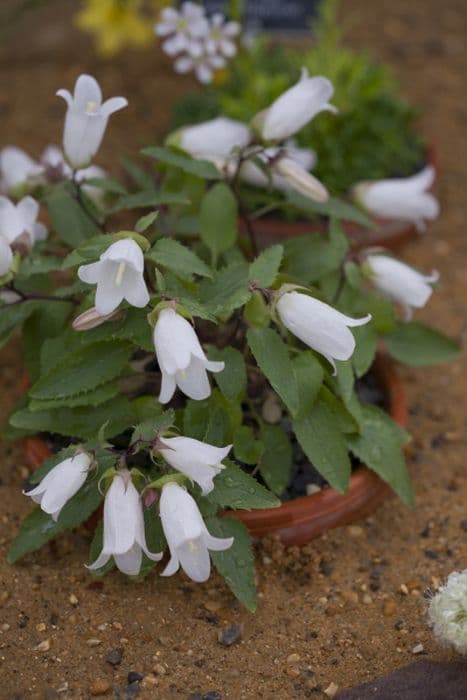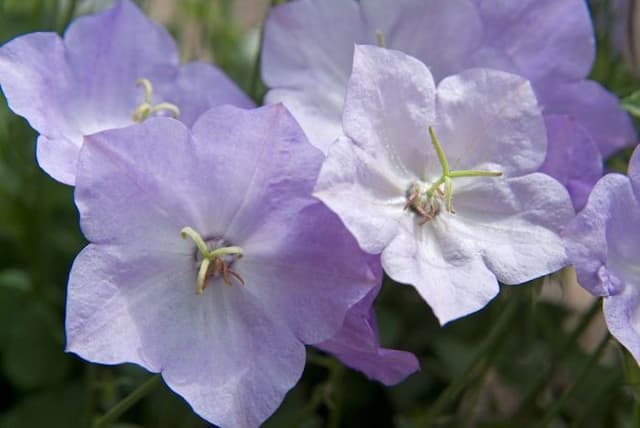Sheep's bit scabious Jasione laevis 'Blaulicht'

ABOUT
The commonly known as Sheep's Bit, displays a plush array of delicate blue flowers that bloom in a globular cluster, akin to a pincushion formation, which is a distinguishing feature of this charming plant. The blooms are vivid and can often appear to have a metallic sheen under sunlight. These spherical flower heads sit atop thin, wiry stems that gently sway with the breeze. The foliage of Sheep's Bit consists of small, narrow leaves that are typically green, forming a low-growing tuft or mat. The leaves are sometimes lance-shaped, with a slightly toothed edge, and they form a rosette at the base. This tight cluster of basal leaves gives the plant a dense and compact appearance at ground level. Throughout its blooming season, Sheep's Bit is a spectacle of fine texture and color. Despite its delicate-looking flowers, it is a hardy plant that brings a wildflower charm to garden settings. The blue flowers attract various pollinators, adding to its allure while providing ecological benefits.
About this plant
 Names
NamesFamily
Campanulaceae
Synonyms
Sheep's Bit, Sheep's Bit Scabious, Blue Light Sheep's Bit
Common names
Jasione perennis, Jasione montana var. laevis, Jasione laevis.
 Toxicity
ToxicityTo humans
The plant known as Sheep's bit does not have a well-documented profile regarding its toxicity to humans. While many plants can have toxic properties, there is no specific information readily available that indicates Sheep's bit is poisonous to humans or any symptoms associated with its ingestion. However, as with any plant, it is generally advisable to avoid ingesting parts of plants unless they are known to be safe to eat.
To pets
For pets, Sheep's bit also does not have a widely recognized record of toxicity. There is no specific information available that suggests Sheep's bit is harmful to domestic animals or any symptoms that may arise from its ingestion. Nonetheless, caution should be taken as individual pets may have unique sensitivities, and it is always best to prevent pets from consuming plants that are not confirmed to be safe for them.
 Characteristics
CharacteristicsLife cycle
Perennials
Foliage type
Deciduous
Color of leaves
Green
Flower color
Blue
Height
1 feet (0.3 meters)
Spread
1 feet (0.3 meters)
Plant type
Herb
Hardiness zones
4
Native area
Europe
Benefits
 General Benefits
General Benefits- Ornamental Appeal: Jasione laevis 'Blaulicht', commonly known as Sheep's-bit, boasts attractive blue flowers that enhance garden aesthetics.
- Drought Tolerance: Sheep's-bit is known for its ability to withstand periods of low water availability, making it suitable for xeriscaping.
- Pollinator-Friendly: The flowers of Sheep's-bit attract bees and butterflies, supporting local pollinator populations.
- Low Maintenance: This plant generally requires minimal care, making it ideal for gardeners looking for low-effort landscaping options.
- Adaptability: Sheep's-bit can thrive in a range of soil types, as long as they are well-draining.
- Compact Size: Its small stature makes it a good choice for rock gardens, borders, and containers where space is limited.
- Seasonal Interest: The plant has a specific blooming season, usually summer, providing a burst of color when many other plants are not in flower.
- Erosion Control: With its capacity to form tight clumps, Sheep's-bit can help stabilize soil and prevent erosion.
 Medical Properties
Medical PropertiesThis plant is not used for medical purposes.
 Air-purifying Qualities
Air-purifying QualitiesThis plant is not specifically known for air purifying qualities.
 Other Uses
Other Uses- Photographic subjects - The striking blue flowers of the Sheep's-bit can be used as captivating subjects or backdrops in macro photography and plant portraiture due to their unique spherical shape and vibrant color.
- Educational tool - Sheep's-bit can serve as an excellent specimen for botany students to study unique flower structures and pollination mechanisms.
- Artistic inspiration - Artists may use Sheep's-bit as a muse for paintings, drawings, and other artworks, capturing its form and color within their pieces.
- Ecological studies - Due to its attractiveness to certain insects, Sheep's-bit can be used in studies to observe pollinator behavior and plant-insect interactions in a given habitat.
- Garden design - Sheep's-bit can be utilized in rock gardens and alpine displays for its adaptability in well-drained soils and contribution to garden aesthetics.
- Dried flower arrangements - The flower heads of Sheep's-bit can be dried and used in everlasting bouquets, adding unique texture and color that lasts.
- Landscape rehabilitation - Sheep's-bit can be included in landscaping projects aimed at rehabilitating disturbed soils as it is relatively hardy and low maintenance.
- Craft projects - Pressed Sheep's-bit flowers can be used in craft projects like making bookmarks, cards, or incorporating into candles for natural decoration.
- Nature crafts - Sheep's-bit flowers can be included in nature-based craft projects for children, such as making flower crowns or decorating fairy gardens.
- Culinary decoration - Although not commonly consumed, the non-toxic flowers could be used as a decorative garnish for desserts or salads to add a splash of color.
Interesting Facts
 Feng Shui
Feng ShuiThe Sheep's Bit is not used in Feng Shui practice.
 Zodiac Sign Compitability
Zodiac Sign CompitabilityThe Sheep's Bit is not used in astrology practice.
 Plant Symbolism
Plant Symbolism- Resilience: Jasione laevis 'Blaulicht', commonly known as Sheep's Bit, often thrives in poor soil and harsh conditions, symbolizing the ability to withstand difficult situations and bounce back.
- Attraction: The vibrant blue flowers of Sheep's Bit are highly attractive to butterflies and bees, representing allure and magnetism in the natural world.
- Harmony with nature: As a wildflower often found in natural meadows, Sheep's Bit embodies the concept of living in balance and harmony with the environment around us.
- Beauty in simplicity: The simple yet striking appearance of Sheep's Bit flowers signifies that beauty can be found in the most unassuming places and does not require complexity.
 Water
WaterThe Sheep's Bit Scabious should be watered thoroughly, allowing the soil to dry out slightly between waterings. In general, providing about one inch of water per week should suffice, but this may vary based on climate and soil conditions. It’s important to avoid overwatering as this plant does not like soggy soil. During the growing season, regular watering is necessary; during dormancy in winter, reduce the frequency. Ensure that you are using well-draining soil to prevent water retention.
 Light
LightSheep's Bit Scabious thrives best in full sun to partial shade. It is ideal to place it in a spot where it can receive at least six hours of sunlight a day. However, in extremely hot climates, some afternoon shade can be beneficial to prevent scorching of the foliage.
 Temperature
TemperatureSheep's Bit Scabious prefers a temperature range between 60°F and 75°F but can tolerate a wider range from around 50°F to 85°F. It is important to protect the plant from extreme temperatures, particularly from prolonged periods of frost which can be damaging.
 Pruning
PruningPrune Sheep's Bit Scabious to deadhead spent flowers and promote further blooming. Pruning can be done throughout the flowering season as necessary. The best time for more extensive pruning to shape the plant or to cut back on old growth is in late winter or early spring before new growth begins.
 Cleaning
CleaningAs needed
 Soil
SoilSheep's-bit 'Blaulicht' thrives best in well-draining, sandy to gritty soil with a slightly acidic to neutral pH of 6.0 to 7.0; a mix of sand, peat, and loam works well.
 Repotting
RepottingSheep's-bit 'Blaulicht' does not require frequent repotting and can be done every 2-3 years or when it outgrows its container.
 Humidity & Misting
Humidity & MistingSheep's-bit 'Blaulicht' prefers moderate humidity levels but is fairly adaptable and can tolerate the drier conditions typical of most indoor environments.
 Suitable locations
Suitable locationsIndoor
Provide bright light and allow soil to dry between waterings.
Outdoor
Plant in full sun to part shade with well-draining soil.
Hardiness zone
4-8 USDA
 Life cycle
Life cycleThe life cycle of Jasione laevis 'Blaulicht', commonly known as the Sheep's Bit, begins with seed germination in fertile, well-drained soil, typically in spring or autumn under temperate climates. After germination, the seedlings establish a rosette of basal leaves and, given suitable conditions, enter a vegetative growth phase where they develop stems and foliage. Following the vegetative stage, Sheep's Bit undergoes flowering, usually in the summer months, where blue, spherical flower heads bloom and attract pollinators for reproduction. After pollination, the flowers develop into seed capsules, which, when ripe, release seeds for dispersal by wind or other means. Completing its life cycle, the plant may die after setting seed if it is an annual, or it may enter dormancy if it is a perennial, surviving through adverse conditions to regrow in the following season. Perennials can also spread vegetatively through the growth of offshoots from the base of the parent plant.
 Propogation
PropogationPropogation time
Spring to summer
Propogation: Jasione laevis 'Blaulicht', commonly known as Sheep's-bit, is most commonly propagated by seed. The best time to sow seeds is in spring after the last frost has passed. Sprinkle the fine seeds onto well-draining soil in a pot or a nursery bed, barely covering them with a thin layer of soil. Ensure they receive plenty of light as it aids in germination. Keep the soil moist but not waterlogged. Seedlings usually emerge within a few weeks. Once they've grown large enough to handle, you can transplant them into their final position in the garden during the cooler parts of the day to reduce transplant shock.









![Milky bellflower [Avalanche]](/_next/image?url=https%3A%2F%2Fplants-admin.emdemapps.com%2Fimages%2Fplants%2F%2Fimages%2F604b5dc88c1e7.png&w=640&q=75)